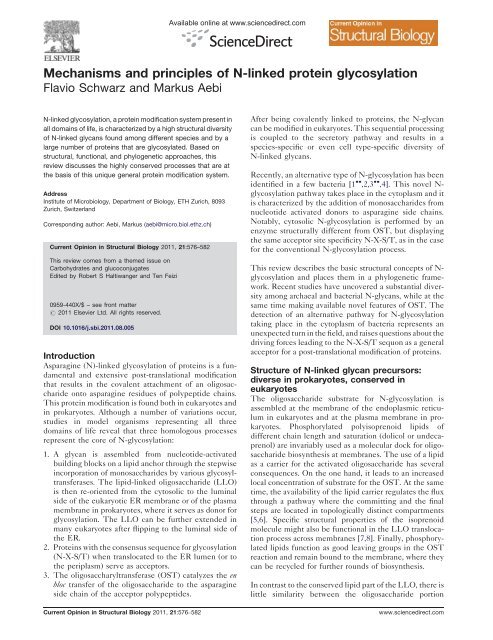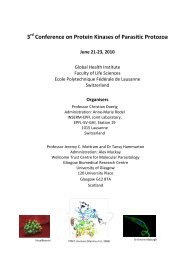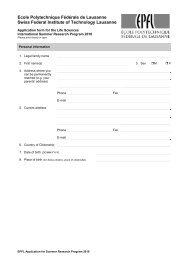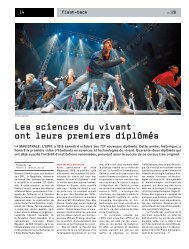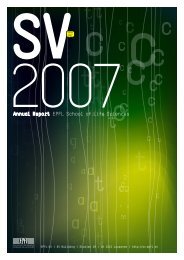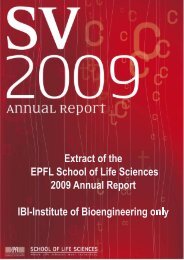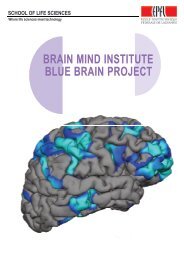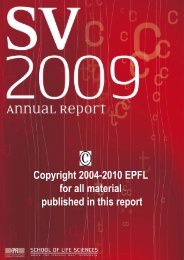Mechanisms and principles of N-linked protein glycosylation - EPFL
Mechanisms and principles of N-linked protein glycosylation - EPFL
Mechanisms and principles of N-linked protein glycosylation - EPFL
Create successful ePaper yourself
Turn your PDF publications into a flip-book with our unique Google optimized e-Paper software.
Available online at www.sciencedirect.com<strong>Mechanisms</strong> <strong>and</strong> <strong>principles</strong> <strong>of</strong> N-<strong>linked</strong> <strong>protein</strong> <strong>glycosylation</strong>Flavio Schwarz <strong>and</strong> Markus AebiN-<strong>linked</strong> <strong>glycosylation</strong>, a <strong>protein</strong> modification system present inall domains <strong>of</strong> life, is characterized by a high structural diversity<strong>of</strong> N-<strong>linked</strong> glycans found among different species <strong>and</strong> by alarge number <strong>of</strong> <strong>protein</strong>s that are glycosylated. Based onstructural, functional, <strong>and</strong> phylogenetic approaches, thisreview discusses the highly conserved processes that are atthe basis <strong>of</strong> this unique general <strong>protein</strong> modification system.AddressInstitute <strong>of</strong> Microbiology, Department <strong>of</strong> Biology, ETH Zurich, 8093Zurich, Switzerl<strong>and</strong>Corresponding author: Aebi, Markus (aebi@micro.biol.ethz.ch)Current Opinion in Structural Biology 2011, 21:576–582This review comes from a themed issue onCarbohydrates <strong>and</strong> glucoconjugatesEdited by Robert S Haltiwanger <strong>and</strong> Ten Feizi0959-440X/$ – see front matter# 2011 Elsevier Ltd. All rights reserved.DOI 10.1016/j.sbi.2011.08.005IntroductionAsparagine (N)-<strong>linked</strong> <strong>glycosylation</strong> <strong>of</strong> <strong>protein</strong>s is a fundamental<strong>and</strong> extensive post-translational modificationthat results in the covalent attachment <strong>of</strong> an oligosaccharideonto asparagine residues <strong>of</strong> polypeptide chains.This <strong>protein</strong> modification is found both in eukaryotes <strong>and</strong>in prokaryotes. Although a number <strong>of</strong> variations occur,studies in model organisms representing all threedomains <strong>of</strong> life reveal that three homologous processesrepresent the core <strong>of</strong> N-<strong>glycosylation</strong>:1. A glycan is assembled from nucleotide-activatedbuilding blocks on a lipid anchor through the stepwiseincorporation <strong>of</strong> monosaccharides by various glycosyltransferases.The lipid-<strong>linked</strong> oligosaccharide (LLO)is then re-oriented from the cytosolic to the luminalside <strong>of</strong> the eukaryotic ER membrane or <strong>of</strong> the plasmamembrane in prokaryotes, where it serves as donor for<strong>glycosylation</strong>. The LLO can be further extended inmany eukaryotes after flipping to the luminal side <strong>of</strong>the ER.2. Proteins with the consensus sequence for <strong>glycosylation</strong>(N-X-S/T) when translocated to the ER lumen (or tothe periplasm) serve as acceptors.3. The oligosaccharyltransferase (OST) catalyzes the enbloc transfer <strong>of</strong> the oligosaccharide to the asparagineside chain <strong>of</strong> the acceptor polypeptides.After being covalently <strong>linked</strong> to <strong>protein</strong>s, the N-glycancan be modified in eukaryotes. This sequential processingis coupled to the secretory pathway <strong>and</strong> results in aspecies-specific or even cell type-specific diversity <strong>of</strong>N-<strong>linked</strong> glycans.Recently, an alternative type <strong>of</strong> N-<strong>glycosylation</strong> has beenidentified in a few bacteria [1 ,2,3 ,4]. This novel N-<strong>glycosylation</strong> pathway takes place in the cytoplasm <strong>and</strong> itis characterized by the addition <strong>of</strong> monosaccharides fromnucleotide activated donors to asparagine side chains.Notably, cytosolic N-<strong>glycosylation</strong> is performed by anenzyme structurally different from OST, but displayingthe same acceptor site specificity N-X-S/T, as in the casefor the conventional N-<strong>glycosylation</strong> process.This review describes the basic structural concepts <strong>of</strong> N-<strong>glycosylation</strong> <strong>and</strong> places them in a phylogenetic framework.Recent studies have uncovered a substantial diversityamong archaeal <strong>and</strong> bacterial N-glycans, while at thesame time making available novel features <strong>of</strong> OST. Thedetection <strong>of</strong> an alternative pathway for N-<strong>glycosylation</strong>taking place in the cytoplasm <strong>of</strong> bacteria represents anunexpected turn in the field, <strong>and</strong> raises questions about thedriving forces leading to the N-X-S/T sequon as a generalacceptor for a post-translational modification <strong>of</strong> <strong>protein</strong>s.Structure <strong>of</strong> N-<strong>linked</strong> glycan precursors:diverse in prokaryotes, conserved ineukaryotesThe oligosaccharide substrate for N-<strong>glycosylation</strong> isassembled at the membrane <strong>of</strong> the endoplasmic reticulumin eukaryotes <strong>and</strong> at the plasma membrane in prokaryotes.Phosphorylated polyisoprenoid lipids <strong>of</strong>different chain length <strong>and</strong> saturation (dolicol or undecaprenol)are invariably used as a molecular dock for oligosaccharidebiosynthesis at membranes. The use <strong>of</strong> a lipidas a carrier for the activated oligosaccharide has severalconsequences. On the one h<strong>and</strong>, it leads to an increasedlocal concentration <strong>of</strong> substrate for the OST. At the sametime, the availability <strong>of</strong> the lipid carrier regulates the fluxthrough a pathway where the committing <strong>and</strong> the finalsteps are located in topologically distinct compartments[5,6]. Specific structural properties <strong>of</strong> the isoprenoidmolecule might also be functional in the LLO translocationprocess across membranes [7,8]. Finally, phosphorylatedlipids function as good leaving groups in the OSTreaction <strong>and</strong> remain bound to the membrane, where theycan be recycled for further rounds <strong>of</strong> biosynthesis.In contrast to the conserved lipid part <strong>of</strong> the LLO, there islittle similarity between the oligosaccharide portionCurrent Opinion in Structural Biology 2011, 21:576–582 www.sciencedirect.com
N-<strong>linked</strong> <strong>protein</strong> <strong>glycosylation</strong> Schwarz <strong>and</strong> Aebi 577generated in prokaryotes <strong>and</strong> in eukaryotes. The bacteriumCampylobacter jejuni decorates <strong>protein</strong>s with a heptasaccharideGlc-GalNAc 5 -Bac (Figure 1) [9], whereasC. lari produces a similar glycan GalNAc 5 -Bac missingthe branching glucose [10]. Helicobacter pullorum synthesizea linear pentasaccharide containing uncharacterizedmonosaccharides <strong>of</strong> 216 <strong>and</strong> 217 Da, which are alsodetected in the N-glycan <strong>of</strong> Wolinella succinogenes[11,12]. Though extensive studies are missing, currentknowledge reveals that an even larger structural diversityis found in the archaea, where glycans can be also modifiedby methylation, sulfation, <strong>and</strong> addition <strong>of</strong> amino acids(Figure 1). For instance, Methanococcus voltae builds atrisaccharide composed <strong>of</strong> ManNAcA6Thr-GlcNAc3-NAcA-GlcNAc [13]. M. maripaludis N-glycans are made<strong>of</strong> the tetrasaccharide Sug-ManNAcNAm-GlcNAcNAcA-GalNAc, amidated with a threonine amino group [14].The diversity is additionally increased in Halobacteriumsalinarum, where two different oligosaccharides areassembled either on dolichyl pyrophosphate or dolichylphosphate,using N-acetylhexosamine or hexose as linkingunits, respectively [15]. Notably, dolichyl phosphate<strong>linked</strong>oligosaccharides have been detected exclusively inarchaea to date [15,16 ].By contrast, in the large majority <strong>of</strong> eukaryotes, a Glc 3 -Man 9 -GlcNAc 2 oligosaccharide is built on a dolichylpyrophosphate carrier by ordered action <strong>of</strong> glycosyltransferases<strong>of</strong> the ALG pathway [5]. Remarkably, some organismsthat branched <strong>of</strong>f early in eukaryotic evolutionproduce smaller versions <strong>of</strong> this glycan [17].Therefore, it appears that archaeal <strong>and</strong> bacterial glycanprecursors are heterogeneous, whereas eukaryotes producea conserved lipid-<strong>linked</strong> oligosaccharide structure(Figure 1). Archaea exhibit the greatest diversity in<strong>glycosylation</strong> pathways: they use a large pool <strong>of</strong> buildingblocks, they produce both dolichyl phosphate-<strong>linked</strong> <strong>and</strong>pyrophosphate-<strong>linked</strong> glycans, <strong>and</strong> they can synthesizemore than one type <strong>of</strong> LLO in the same cell. Bacteriadisplay a limited diversity, <strong>and</strong> N-<strong>glycosylation</strong> is confinedto a small number <strong>of</strong> species. By contrast, eukaryotespresent a conserved core unit Man 5 -GlcNAc 2 ,extended with luminal added units to Glc 3 -Man 9 -GlcNAc 2 . The remarkable diversity <strong>of</strong> N-glycans foundamong eukaryotes is a consequence <strong>of</strong> a successive elaborationtaking place in the late ER <strong>and</strong> in the Golgi,featuring a different evolutionary origin. The reason forthis convergent process in N-<strong>glycosylation</strong> is probablybound to the function <strong>of</strong> the glycan structures <strong>and</strong> thecompartment where they are localized. In prokaryotes,<strong>protein</strong>s are modified in the periplasm <strong>and</strong> maintainedoutside. Instead, the homologous process in eukaryotestakes place in the ER, where it is vitally bound to thefolding events <strong>of</strong> glyco<strong>protein</strong>s. The N-glycan is elaboratedonce the glyco<strong>protein</strong> is destined to the outside <strong>of</strong>the cell. The resulting high diversity <strong>of</strong> extracellularglycans can be viewed as the result <strong>of</strong> similar selectionFigure 1Diversity2 SO 42-CH 3SCH 33 SO2- Thr4SO 3-QBBPPtoPPArchaeaBacteriaEukayotesDolicholUndecaprenolPhosphateGalacturonic acid (GalA)Iduronic acid (IdoA)Glucoronic acid (GlcA)Hexuronic acid (HexA)Galactose (Gal)Glucose (Glc)Mannose (Man)Hexose (Hex)BSQN-Acetylgalactosamine (GalNAc)N-Acetylglucosamine (GlcNAc)N-Acetylmannosamine (ManNAc)N-Acetylhexosamine (HexNAc)2,4-Diacetamido-2,4,6-trideoxy-glucose (Bacillosamine, Bac)2-Acetamido-2,4-dideoxy-5-O-methyl-erythro-hexos-5-ulo-1,5-pyranose (Sug)QuinovoseUncharacterized sugarUncharacterized sugarCurrent Opinion in Structural BiologyN-<strong>glycosylation</strong> occurs in all domains <strong>of</strong> life, but the glycan being transferred is different. Prokaryotes synthesize a variety <strong>of</strong> lipid-<strong>linked</strong>oligosaccharides, whereas eukaryotes produce a conserved structure. Representative glycan structures are indicated with colored geometricsymbols, conform to those recommended by the Consortium for Functional Glycomics.www.sciencedirect.com Current Opinion in Structural Biology 2011, 21:576–582
578 Carbohydrates <strong>and</strong> glucoconjugatesmechanisms acting on two different processes <strong>of</strong> theN-<strong>linked</strong> <strong>protein</strong> <strong>glycosylation</strong>.The N-X-S/T sequon: a unique acceptorsequence conserved in N-<strong>glycosylation</strong>The acceptor substrate <strong>of</strong> N-<strong>glycosylation</strong> is an asparagineresidue present within the consensus sequence N-X-S/T [18]. Site occupancy analysis <strong>of</strong> different modelglyco<strong>protein</strong>s shows a preference for N-X-T sites overN-X-S [19,20], <strong>and</strong> reveals that proline is not tolerated inthe second position. Based on these findings, it has beenhypothesized that a specific conformation <strong>of</strong> the acceptorpeptide is required to increase the nucleophilicity <strong>of</strong> theamide group <strong>of</strong> the asparagine [21,22]. These models linkthe generation <strong>of</strong> the reactive intermediates to the formation<strong>of</strong> a secondary structure <strong>and</strong> functionally dependon the presence <strong>of</strong> the hydroxyl amino acid at the +2position. However, recent experimental data questionthese ideas. Exchange <strong>of</strong> serine for valine, leucine orasparagine in the sequon N-A-S does not prevent <strong>glycosylation</strong><strong>of</strong> the cell surface glyco<strong>protein</strong> from the archaeaHalobacterium halobium [23]. The OST from the bacteriumC. lari is able to modify the N-S-G site <strong>of</strong> a <strong>protein</strong>[10]. Four non-consensus sequences are glycosylated inIgG Fc purified from CHO cells [24 ,25 ]. Lastly, N-<strong>glycosylation</strong>s are detected at 24 N-G-X <strong>and</strong> 68 N-X-Vsites in the mouse glycoproteome [26 ]. Therefore, itappears that the sequence requirements <strong>of</strong> the acceptorsubstrate are less strict than previously stated. Serine orthreonine in the third position is important, but can bedispensable for the glycosyl transfer reaction mediated bythe OST.Nevertheless, N-<strong>glycosylation</strong> sequons have to adopt aspecific conformation during the reaction process. Therequirement <strong>of</strong> flexibility at the N-X-S/T has found amolecular description for the bacterial system, whichrepresents an optimal experimental model as <strong>glycosylation</strong>takes place after <strong>protein</strong> folding [27]. NMR spectroscopy<strong>of</strong> a <strong>protein</strong> substrate demonstrates that abacterial <strong>glycosylation</strong> site is located on moderately flexibleregions, but does not adopt a predefined motif [28].Therefore, a defined secondary structure seems notessential for recognition <strong>of</strong> the substrate, but it mightbe imposed upon binding to the OST.It is remarkable that the bacterial cytoplasmic N-glycosyltransferase(NGT) HMW1Crecognizes the same consensussequence N-X-S/T [1 ,3 ]. Similar to OST,NGT is an inverting glycosyltransferase <strong>and</strong> can modifypeptides featuring sequences <strong>of</strong> eukaryotic glyco<strong>protein</strong>s(Schwarz, Fan, Schubert, Aebi, manuscript in preparation).Replacement <strong>of</strong> the asparagine to glutamineor presence <strong>of</strong> proline in the +1 position impairs <strong>glycosylation</strong>.NGT does not share sequence identity to theOST, <strong>and</strong> the two enzymes belong to structurally unrelatedclasses. Therefore, the same substrate requirementsemerged in two independent pathways resulting in analogousenzymatic activity. Considering the hypothesisthat the hydroxyl amino acid is not directly involved inthe catalytic mechanism <strong>of</strong> OST, it remains unexplainedwhy <strong>glycosylation</strong> at asparagine side chains, whichevolved independently (at least) twice, favored asparagineversus glutamine, <strong>and</strong> selected a consensus sequencewith a hydroxyl amino acid at the +2 position relative tothe asparagine.It is evident that a short recognition element is a prerequisitefor the observed evolutionary trends in N-glycanmultiplicity in specific sets <strong>of</strong> <strong>protein</strong>s [29,30]. Once the<strong>glycosylation</strong> machinery is in place, emergence <strong>of</strong> newsequons on <strong>protein</strong>s leads to additional N-<strong>glycosylation</strong>s,which are then subject to selection. Given a potentialbeneficial effect <strong>of</strong> the N-glycan modification, a pathwaywith a short recognition motif is likely to develop into ageneral modification system <strong>of</strong> <strong>protein</strong>s. Indeed, analysis<strong>of</strong> mutations in a set <strong>of</strong> human genes encoding <strong>protein</strong>stransiting trough the secretory pathway illustrates thatmutations resulting in a gain-<strong>of</strong>-<strong>glycosylation</strong> phenotypeare over-represented [31].OST specificity defines the complexity <strong>of</strong> theglycoproteomeThe view that there is a selective advantage <strong>of</strong> a ‘general’N-<strong>glycosylation</strong> system is further supported by a phylogeneticanalysis <strong>of</strong> the central enzyme <strong>of</strong> the pathway.The Stt3 <strong>protein</strong> accounts alone for OST activity in someorganisms. In fact, bacterial <strong>and</strong> archaeal Stt3 homologs(called PglB or AglB) glycosylate <strong>protein</strong>s <strong>and</strong> peptides[32,33,34 ,35]. Similarly, some protists express Stt3<strong>protein</strong>s that are self-sufficient for oligosaccharide transfer[36,37]. By contrast, in complex eukaryotes such asfungi, animals <strong>and</strong> plants, the OST works as a multi<strong>protein</strong>complex made <strong>of</strong> up to eight polypeptides, builtas an extension <strong>of</strong> the Stt3 core [38].In multimeric OSTs, some <strong>of</strong> the additional subunits finetunethe <strong>glycosylation</strong> process. Ost1p acts as a chaperon topromote <strong>glycosylation</strong> <strong>of</strong> selected <strong>protein</strong> clients [39–41].Ost3/6p exhibit oxidoreductase activity <strong>and</strong> bind specificpolypeptides, both non-covalently <strong>and</strong> via transient disulfidebonds [42]. These subunits are thought to slow downthe early stages <strong>of</strong> <strong>protein</strong> folding, thereby maintaining thepolypeptide chain in a <strong>glycosylation</strong>-competent conformation.Interactions among OST subunits <strong>and</strong> the transloconmight also increase the versatility <strong>of</strong> the system byexecuting <strong>glycosylation</strong> on the nascent polypeptides,before folding <strong>of</strong> the <strong>protein</strong> [43]. In this view, some <strong>of</strong>the auxiliary OST subunits enlarge the substrate range <strong>of</strong>the enzyme (Figure 2). Alternatively, other eukaryotesextend their <strong>glycosylation</strong> ability by duplication <strong>of</strong> theSTT3 gene <strong>and</strong> diversification <strong>of</strong> Stt3 specificity. Trypanosomabrucei Stt3 paralogs exhibit distinct acceptor specificity:TbStt3A is highly selective for acidic peptideCurrent Opinion in Structural Biology 2011, 21:576–582 www.sciencedirect.com
N-<strong>linked</strong> <strong>protein</strong> <strong>glycosylation</strong> Schwarz <strong>and</strong> Aebi 579Figure 2EukaryotesOST complexMultiple single-subunitsSaccharomyces cerevisiaeOst1pWbp1pSwp1p Stt3pOst3/6pOst5p Ost2p Ost4pTrypanosoma bruceiStt3A Stt3B Stt3CBacteriaSingle-subunitCampylobacterPglBX-X-X-X-N-X-S/T-X sequence modifiedCurrent Opinion in Structural BiologyThe composition <strong>of</strong> OST correlates to the complexity <strong>of</strong> the glycoproteome. The x axis describes the range <strong>of</strong> peptides that can be modified by distinctOSTs. Stt3 acceptor specificity is indicated in green. Campylobacter possesses a single-subunit OST <strong>and</strong> generally modifies peptides <strong>of</strong> sequence D/E-X 1 -N-X +1 -S/T. The light green bar represents the relaxed specificity <strong>of</strong> C. lari OST. T. brucei Stt3 <strong>protein</strong>s feature distinct, yet overlappingspecificities for the acceptor sequon. In S. cerevisiae, the range <strong>of</strong> peptides is extended by the distinct activity <strong>of</strong> OST subunits (indicated in red), whichcan bind specific polypeptides <strong>and</strong> expose them to the Stt3 catalytic subunit.acceptor sites, TbStt3B has a broad specificity for theacceptor sites, whereas TbStt3C preferentially glycosylatesacidic peptide acceptors [36]. This alternative strategyresults in a pr<strong>of</strong>icient system, in which the complexity <strong>of</strong>the glycoproteome is the result <strong>of</strong> the cumulative activity <strong>of</strong>multiple OSTs (Figure 2). Multiple copies <strong>of</strong> STT3 genesare also found within bacterial <strong>and</strong> archaeal genomes[44 ,45]. Interestingly, whereas some STT3 homologs areclosely grouped <strong>and</strong> probably derive from gene duplicationevents as in protists, others are distantly related. By contrast,for bacterial systems the consensus sequence N-X-S/T is extended at the amino-terminus to present aspartic orglutamic acid in the -2 position relative to the asparagine[10,12,46]. Therefore, bacterial OSTs exhibit a more stringentspecificity for the acceptor site than the eukaryoticcounterpart. This restricts <strong>glycosylation</strong> to a narrow set <strong>of</strong>polypeptides (Figure 2).In light <strong>of</strong> the above, it is tempting to speculate thatN-<strong>glycosylation</strong> is a process that descends from anarchaeal ancestor. N-<strong>glycosylation</strong> is ubiquitous amongarchaea, where there is the highest diversity <strong>of</strong> glycanstructures, <strong>and</strong> multiple N-<strong>glycosylation</strong> pathways arefound within the same genome. Deep-sea vents mighthave been the environment where the geneticinformation for N-<strong>glycosylation</strong> was transferred fromthermophilic archaea (usually possessing the <strong>glycosylation</strong>genes organized in a cluster) to some e-proteobacteria[44 ,47]. Evident similarities between the lipidcycles that assist peptidoglycan <strong>and</strong> O-antigen biosynthesisin bacteria <strong>and</strong> N-<strong>glycosylation</strong> in archaea madethe functional transfer <strong>of</strong> this <strong>protein</strong> modification tobacteria possible [48]. Along the same line <strong>of</strong> argumentation,the eukaryotic progenitor probably contained a<strong>glycosylation</strong> machinery <strong>of</strong> the prokaryotic type, featuringa single subunit OST <strong>and</strong> the cytosolic segment <strong>of</strong>the LLO biosynthetic pathway. It is this pathway thatmight be the most primitive eukaryotic N-<strong>glycosylation</strong>system. Lower eukaryotes producing smaller versions<strong>of</strong> the Glc 3 Man 9 GlcNAc 2 glycan therefore representevolutionary intermediates lacking some <strong>of</strong> the ERglycosyltransferases. However, alternative views startingfrom a complete ER-<strong>glycosylation</strong> machinery havebeen proposed [49].A functional view <strong>of</strong> eukaryotic N-glycanstructureThe biosynthetic route <strong>of</strong> the eukaryotic LLO is dividedinto two branches (Figure 3). The first part resemblesthat <strong>of</strong> archaea, as it occurs at the cytosolic side <strong>and</strong>www.sciencedirect.com Current Opinion in Structural Biology 2011, 21:576–582
580 Carbohydrates <strong>and</strong> glucoconjugatesFigure 3Alg3Alg9Alg12Alg6Alg8Alg10NPPPPNPPPAlg7Alg1Alg2Alg11cytosolic GTs ER-resident GTs Golgi-resident GTsancientrecent<strong>protein</strong> stabilityquality controlERADcell-cell communicationmodulation <strong>of</strong> activityCurrent Opinion in Structural BiologyRelating oligosaccharide structures <strong>of</strong> eukaryotes to biological function. Glycosyltransferases involved in the process <strong>of</strong> N-<strong>glycosylation</strong> are divided inthree groups reflecting their location, their phylogenetic origin, <strong>and</strong> their function in N-glycan biosynthesis. The resulting structures are associated tothe different functions <strong>of</strong> N-<strong>linked</strong> glycans.glycosyltransferases build the Man 5 -GlcNAc 2 glycan byusing nucleotide activated monosaccharides. After translocation<strong>of</strong> LLO to the ER lumen, glycosyltransferases <strong>of</strong>a different class complete the glycan structure by utilizingdolichyl phosphate-activated monosaccharides.Notably, these glycosyltransferases seem to share a commonancestor [50], <strong>and</strong> cluster in the same family <strong>of</strong>enzymes that build glycosylphosphatidylinositol (GPI)membrane anchors.Hydrophilic N-glycans are major contributors to thermodynamicstability <strong>and</strong> solubility <strong>of</strong> <strong>protein</strong>s [51,52 ,53].This general effect is not directly related to the glycanstructure, <strong>and</strong> it is also detectable in organisms where N-<strong>glycosylation</strong> is not essential for viability, such as archaea<strong>and</strong> bacteria [54,55 ].By contrast, the oligosaccharide portions formed in theER are a distant appendix that do not interact with the<strong>protein</strong> backbone. Terminal glucoses <strong>and</strong> mannoses incombination with lectin receptors create a system ableto assist folding <strong>of</strong> newly synthesized <strong>protein</strong>s <strong>and</strong> tosort out <strong>and</strong> direct misfolded polypeptide to degradation[56]. The ability to control folding <strong>of</strong> <strong>protein</strong>smight have been the driving force for the evolution <strong>of</strong>the Glc 3 -Man 9 -GlcNAc 2 oligosaccharide <strong>and</strong> its conservationamong eukaryotes. The selective advantagegiven by this system probably resides in the capacity<strong>of</strong> producing <strong>protein</strong>s <strong>of</strong> increased complexity <strong>and</strong> <strong>of</strong>novel function.The topological division <strong>of</strong> the N-<strong>glycosylation</strong> pathwayinto ER <strong>and</strong> Golgi marks both a biosynthetic <strong>and</strong> afunctional difference <strong>of</strong> oligosaccharides. Golgi glycosyltransferasesbelong to the family <strong>of</strong> type II membrane<strong>protein</strong>s <strong>and</strong> use nucleotide-activated monosaccharidesas donors to elaborate the core glycans into complexstructures. Whereas the transfer <strong>of</strong> the Glc 3 -Man 9 -GlcNAc 2 occurs en bloc <strong>and</strong> thus results in homogeneousglycoconjugates, these later additions <strong>of</strong> monosaccharidesoccur sequentially <strong>and</strong> allow for a superior flexibilityin the generation <strong>of</strong> terminal elaborations. This‘explosion <strong>of</strong> diversity’ [30] occurred in plants <strong>and</strong>animals <strong>and</strong> resulted in a tremendous diversity <strong>of</strong> carbohydratestructures displayed at the cell surface. Novelfunctions such as cell–cell interaction required in processeslike development or host-pathogen interactionsare built on N-glycan structure [57].Current Opinion in Structural Biology 2011, 21:576–582 www.sciencedirect.com
N-<strong>linked</strong> <strong>protein</strong> <strong>glycosylation</strong> Schwarz <strong>and</strong> Aebi 581Conclusions <strong>and</strong> perspectivesThe model that we propose allows for a phylogeneticinterpretation <strong>of</strong> the N-<strong>glycosylation</strong> process. This view isbased on a structural framework characterized in differentmodel systems. The better we underst<strong>and</strong> the differentmechanisms <strong>of</strong> N-<strong>linked</strong> <strong>glycosylation</strong> at a molecularlevel, the clearer we can formulate the underlying <strong>principles</strong>.For instance, determining the catalytic mechanism<strong>of</strong> OST <strong>and</strong> NGT will be important to recognize howthese two enzymes activate the poorly reactive amidegroup. These data will also shed light on the drivingforces that selected the N-X-S/T consensus sequence as ageneral recognition element. The definition <strong>of</strong> the occurrence<strong>of</strong> NGT-based N-<strong>glycosylation</strong> in a proteome willdelineate the molecular constraints that lead on the oneside to a seemingly specific <strong>protein</strong> modification system(NGT), <strong>and</strong> on the other side to the unique system wherea single enzyme (OST) can modify thous<strong>and</strong>s <strong>of</strong> siteswithin a given proteome.AcknowledgementsResearch in the Aebi laboratory is supported by the Swiss National ScienceFoundation <strong>and</strong> the ETH Zurich.References <strong>and</strong> recommended readingPapers <strong>of</strong> particular interest, published within the period <strong>of</strong> review,have been highlighted as:1. <strong>of</strong> special interest <strong>of</strong> outst<strong>and</strong>ing interestChoi KJ, Grass S, Paek S, St Geme JW 3rd, Yeo HJ: TheActinobacillus pleuropneumoniae HMW1C-likeglycosyltransferase mediates N-<strong>linked</strong> <strong>glycosylation</strong> <strong>of</strong> theHaemophilus influenzae HMW1 adhesin. PLoS ONE 2010,5:e15888.See reference [3 ].2. Grass S, Buscher AZ, Swords WE, Apicella MA, Barenkamp SJ,Ozchlewski N, St Geme JW 3rd: The Haemophilus influenzaeHMW1 adhesin is glycosylated in a process that requiresHMW1C <strong>and</strong> phosphoglucomutase, an enzyme involved inlipooligosaccharide biosynthesis. Mol Microbiol 2003,48:737-751.3.Grass S, Lichti CF, Townsend RR, Gross J, St Geme JW 3rd: TheHaemophilus influenzae HMW1C <strong>protein</strong> is aglycosyltransferase that transfers hexose residues toasparagine sites in the HMW1 adhesin. PLoS Pathog 2010,6:e1000919.Together with reference [1 ], this study demonstrates that HMW1Chomologs exhibit N-glycosyltransferase activity <strong>and</strong> are able to transferglucose or galactose to the N-X-S/T sites <strong>of</strong> the HMW1A adhesin.4. Gross J, Grass S, Davis AE, Gilmore-Erdmann P, Townsend RR, StGeme JW 3rd: The Haemophilus influenzae HMW1 adhesin is aglyco<strong>protein</strong> with an unusual N-<strong>linked</strong> carbohydratemodification. J Biol Chem 2008, 283:26010-26015.5. Burda P, Aebi M: The dolichol pathway <strong>of</strong> N-<strong>linked</strong><strong>glycosylation</strong>. Biochim Biophys Acta 1999, 1426:239-257.6. Valvano MA: Undecaprenyl phosphate recycling comes out <strong>of</strong>age. Mol Microbiol 2008, 67:232-235.7. Zhou GP, Troy FA 2nd: NMR study <strong>of</strong> the preferred membraneorientation <strong>of</strong> polyisoprenols (dolichol) <strong>and</strong> the impact <strong>of</strong> theircomplex with polyisoprenyl recognition sequence peptides onmembrane structure. Glycobiology 2005, 15:347-359.8. Zhou GP, Troy FA 2nd: Characterization by NMR <strong>and</strong>molecular modeling <strong>of</strong> the binding <strong>of</strong> polyisoprenols <strong>and</strong>polyisoprenyl recognition sequence peptides: 3D structure <strong>of</strong>the complexes reveals sites <strong>of</strong> specific interactions.Glycobiology 2003, 13:51-71.9. Young NM, Brisson JR, Kelly J, Watson DC, Tessier L, Lanthier PH,Jarrell HC, Cadotte N, St Michael F, Aberg E et al.: Structure <strong>of</strong> theN-<strong>linked</strong> glycan present on multiple glyco<strong>protein</strong>s in theGram-negative bacterium, Campylobacter jejuni. J Biol Chem2002, 277:42530-42539.10. Schwarz F, Lizak C, Fan YY, Fleurkens S, Kowarik M, Aebi M:Relaxed acceptor site specificity <strong>of</strong> bacterialoligosaccharyltransferase in vivo. Glycobiology 2011, 21:45-54.11. Anne Dell AG, Federico Sastre, Paul Hitchen: Similarities <strong>and</strong>differences in the <strong>glycosylation</strong> mechanisms in prokaryotes<strong>and</strong> eukaryotes. Int J Microbiol 2010, 2010:.12. Jervis AJ, Langdon R, Hitchen P, Lawson AJ, Wood A,Fothergill JL, Morris HR, Dell A, Wren B, Linton D:Characterization <strong>of</strong> N-<strong>linked</strong> <strong>protein</strong> <strong>glycosylation</strong> inHelicobacter pullorum. J Bacteriol 2010, 192:5228-5236.13. Chaban B, Voisin S, Kelly J, Logan SM, Jarrell KF: Identification <strong>of</strong>genes involved in the biosynthesis <strong>and</strong> attachment <strong>of</strong>Methanococcus voltae N-<strong>linked</strong> glycans: insight intoN-<strong>linked</strong> <strong>glycosylation</strong> pathways in Archaea. Mol Microbiol2006, 61:259-268.14. Kelly J, Logan SM, Jarrell KF, VanDyke DJ, Vinogradov E: A novelN-<strong>linked</strong> flagellar glycan from Methanococcus maripaludis.Carbohydr Res 2009, 344:648-653.15. Lechner J, Wiel<strong>and</strong> F: Structure <strong>and</strong> biosynthesis <strong>of</strong> prokaryoticglyco<strong>protein</strong>s. Annu Rev Biochem 1989, 58:173-194.16.Guan Z, Naparstek S, Kaminski L, Konrad Z, Eichler J: Distinctglycan-charged phosphodolichol carriers are required for theassembly <strong>of</strong> the pentasaccharide N-<strong>linked</strong> to the Hal<strong>of</strong>eraxvolcanii S-layer glyco<strong>protein</strong>. Mol Microbiol 2010, 78:1294-1303.The characterization <strong>of</strong> the lipid-<strong>linked</strong> oligosaccharides from Hal<strong>of</strong>eraxvolcanii reveals that glycans are assembled on dolichyl monophosphate,<strong>and</strong> that the final N-glycan structure is the product <strong>of</strong> a sequential addition<strong>of</strong> glycans originating from distinct phosphorylated dolichyl carriers.17. Kelleher DJ, Banerjee S, Cura AJ, Samuelson J, Gilmore R:Dolichol-<strong>linked</strong> oligosaccharide selection by theoligosaccharyltransferase in protist <strong>and</strong> fungal organisms.J Cell Biol 2007, 177:29-37.18. Marshall RD: The nature <strong>and</strong> metabolism <strong>of</strong> the carbohydratepeptidelinkages <strong>of</strong> glyco<strong>protein</strong>s. Biochem Soc Symp1974:17-26.19. Gavel Y, von Heijne G: Sequence differences betweenglycosylated <strong>and</strong> non-glycosylated Asn-X-Thr/Ser acceptorsites: implications for <strong>protein</strong> engineering. Protein Eng 1990,3:433-442.20. Chen MM, Glover KJ, Imperiali B: From peptide to <strong>protein</strong>:comparative analysis <strong>of</strong> the substrate specificity <strong>of</strong> N-<strong>linked</strong><strong>glycosylation</strong> in C. jejuni. Biochemistry 2007, 46:5579-5585.21. Imperiali B, Shannon KL, Unno M, Rickert KW: A mechanisticproposal for asparagine-<strong>linked</strong> <strong>glycosylation</strong>. J Am Chem Soc1992, 114:7944-7945.22. Bause E, Legler G: The role <strong>of</strong> the hydroxy amino acid in thetriplet sequence Asn-Xaa-Thr(Ser) for the N-<strong>glycosylation</strong>step during glyco<strong>protein</strong> biosynthesis. Biochem J 1981,195:639-644.23. Zeitler R, Hochmuth E, Deutzmann R, Sumper M: Exchange <strong>of</strong>Ser-4 for Val, Leu or Asn in the sequon Asn-Ala-Ser does notprevent N-<strong>glycosylation</strong> <strong>of</strong> the cell surface glyco<strong>protein</strong> fromHalobacterium halobium. Glycobiology 1998, 8:1157-1164.24.Valliere-Douglass JF, Eakin CM, Wallace A, Ketchem RR, Wang W,Treuheit MJ, Ball<strong>and</strong> A: Glutamine-<strong>linked</strong> <strong>and</strong> non-consensusasparagine-<strong>linked</strong> oligosaccharides present in humanrecombinant antibodies define novel <strong>protein</strong> <strong>glycosylation</strong>motifs. J Biol Chem 2010, 285:16012-16022.See reference [25 ].25.Valliere-Douglass JF, Kodama P, Mujacic M, Brady LJ, Wang W,Wallace A, Yan B, Reddy P, Treuheit MJ, Ball<strong>and</strong> A: Asparagine-www.sciencedirect.com Current Opinion in Structural Biology 2011, 21:576–582
582 Carbohydrates <strong>and</strong> glucoconjugates<strong>linked</strong> oligosaccharides present on a non-consensus aminoacid sequence in the CH1 domain <strong>of</strong> human antibodies.J Biol Chem 2009, 284:32493-32506.Together with reference [24 ], this work presents a detailed analysis <strong>of</strong><strong>glycosylation</strong> at asparagine residues <strong>of</strong> non-consensus sequences <strong>of</strong>IgG1 <strong>and</strong> IgG2.26. Zielinska DF, Gnad F, Wisniewski JR, Mann M: Precision mapping <strong>of</strong> an in vivo N-glycoproteome reveals rigidtopological <strong>and</strong> sequence constraints. Cell 2010,141:897-907.This in depth analysis <strong>of</strong> the mouse glycoproteome using high-accuracymass spectrometry uncovers the occurrence <strong>of</strong> N-glycans at several nonconsensussequences.27. Kowarik M, Numao S, Feldman MF, Schulz BL, Callewaert N,Kiermaier E, Catrein I, Aebi M: N-<strong>linked</strong> <strong>glycosylation</strong> <strong>of</strong> folded<strong>protein</strong>s by the bacterial oligosaccharyltransferase. Science2006, 314:1148-1150.28. Slynko V, Schubert M, Numao S, Kowarik M, Aebi M, Allain FH:NMR structure determination <strong>of</strong> a segmentally labeledglyco<strong>protein</strong> using in vitro <strong>glycosylation</strong>. J Am Chem Soc 2009,131:1274-1281.29. Rao RS, Buus OT, Wollenweber B: Evolutionary pattern <strong>of</strong>N-<strong>glycosylation</strong> sequon numbers in eukaryotic ABC <strong>protein</strong>superfamilies. Bioinform Biol Insights 2010, 4:9-17.30. Dennis JW, Nabi IR, Demetriou M: Metabolism, cell surfaceorganization, <strong>and</strong> disease. Cell 2009, 139:1229-1241.31. Vogt G, Chapgier A, Yang K, Chuzhanova N, Feinberg J, Fieschi C,Boisson-Dupuis S, Alcais A, Filipe-Santos O, Bustamante J et al.:Gains <strong>of</strong> <strong>glycosylation</strong> comprise an unexpectedly large group<strong>of</strong> pathogenic mutations. Nat Genet 2005, 37:692-700.32. Feldman MF, Wacker M, Hern<strong>and</strong>ez M, Hitchen PG, Marolda CL,Kowarik M, Morris HR, Dell A, Valvano MA, Aebi M: EngineeringN-<strong>linked</strong> <strong>protein</strong> <strong>glycosylation</strong> with diverse O antigenlipopolysaccharide structures in Escherichia coli. Proc NatlAcad Sci USA 2005, 102:3016-3021.33. Glover KJ, Weerapana E, Numao S, Imperiali B: Chemoenzymaticsynthesis <strong>of</strong> glycopeptides with PglB, a bacterialoligosaccharyl transferase from Campylobacter jejuni.Chem Biol 2005, 12:1311-1315.34.Igura M, Maita N, Kamishikiryo J, Yamada M, Obita T, Maenaka K,Kohda D: Structure-guided identification <strong>of</strong> a new catalyticmotif <strong>of</strong> oligosaccharyltransferase. EMBO J 2008,27:234-243.Important study that reveals the architecture <strong>of</strong> the C-terminal solubledomain <strong>of</strong> Pyrococcus furiosus STT3.35. Abu-Qarn M, Yurist-Doutsch S, Giordano A, Trauner A, Morris HR,Hitchen P, Medalia O, Dell A, Eichler J: Hal<strong>of</strong>erax volcanii AglB<strong>and</strong> AglD are involved in N-<strong>glycosylation</strong> <strong>of</strong> the S-layerglyco<strong>protein</strong> <strong>and</strong> proper assembly <strong>of</strong> the surface layer.J Mol Biol 2007, 374:1224-1236.36. Izquierdo L, Schulz BL, Rodrigues JA, Guther ML, Procter JB,Barton GJ, Aebi M, Ferguson MA: Distinct donor <strong>and</strong> acceptorspecificities <strong>of</strong> Trypanosoma bruceioligosaccharyltransferases. EMBO J 2009.37. Nasab FP, Schulz BL, Gamarro F, Parodi AJ, Aebi M: All in one:Leishmania major STT3 <strong>protein</strong>s substitute for the wholeoligosaccharyltransferase complex in Saccharomycescerevisiae. Mol Biol Cell 2008, 19:3758-3768.38. Kelleher DJ, Gilmore R: An evolving view <strong>of</strong> the eukaryoticoligosaccharyltransferase. Glycobiology 2006, 16:47R-62R.39. Wilson CM, Kraft C, Duggan C, Ismail N, Crawshaw SG, High S:Ribophorin I associates with a subset <strong>of</strong> membrane <strong>protein</strong>safter their integration at the sec61 translocon. J Biol Chem2005, 280:4195-4206.40. Wilson CM, High S: Ribophorin I acts as a substrate-specificfacilitator <strong>of</strong> N-<strong>glycosylation</strong>. J Cell Sci 2007, 120:648-657.41. Wilson CM, Roebuck Q, High S: Ribophorin I regulates substratedelivery to the oligosaccharyltransferase core. Proc Natl AcadSci USA 2008, 105:9534-9539.42. Schulz BL, Stirnimann CU, Grimshaw JP, Brozzo MS, Fritsch F,Mohorko E, Capitani G, Glockshuber R, Grutter MG, Aebi M:Oxidoreductase activity <strong>of</strong> oligosaccharyltransferasesubunits Ost3p <strong>and</strong> Ost6p defines site-specific <strong>glycosylation</strong>efficiency. Proc Natl Acad Sci USA 2009, 106:11061-11066.43. Chavan M, Yan A, Lennarz WJ: Subunits <strong>of</strong> the transloconinteract with components <strong>of</strong> the oligosaccharyl transferasecomplex. J Biol Chem 2005, 280:22917-22924.44.Magidovich H, Eichler J: Glycosyltransferases <strong>and</strong>oligosaccharyltransferases in Archaea: putative components<strong>of</strong> the N-<strong>glycosylation</strong> pathway in the third domain <strong>of</strong> life.FEMS Microbiol Lett 2009, 300:122-130.Careful analysis <strong>of</strong> the occurrence <strong>of</strong> genes involved in the N-<strong>glycosylation</strong>pathways <strong>of</strong> archaea.45. Jervis AJ, Langdon R, Hitchen P, Lawson AJ, Wood A,Fothergill JL, Morris HR, Dell A, Wren B, Linton D:Characterisation <strong>of</strong> N-<strong>linked</strong> <strong>protein</strong> <strong>glycosylation</strong> inHelicobacter pullorum. J Bacteriol 2010.46. Kowarik M, Young NM, Numao S, Schulz BL, Hug I, Callewaert N,Mills DC, Watson DC, Hern<strong>and</strong>ez M, Kelly JF et al.: Definition <strong>of</strong>the bacterial N-<strong>glycosylation</strong> site consensus sequence. EMBOJ 2006, 25:1957-1966.47. Nakagawa S, Takaki Y, Shimamura S, Reysenbach AL, Takai K,Horikoshi K: Deep-sea vent epsilon-proteobacterial genomesprovide insights into emergence <strong>of</strong> pathogens. Proc Natl AcadSci USA 2007, 104:12146-12150.48. Bugg TD, Br<strong>and</strong>ish PE: From peptidoglycan to glyco<strong>protein</strong>s:common features <strong>of</strong> lipid-<strong>linked</strong> oligosaccharidebiosynthesis. FEMS Microbiol Lett 1994, 119:255-262.49. Samuelson J, Banerjee S, Magnelli P, Cui J, Kelleher DJ,Gilmore R, Robbins PW: The diversity <strong>of</strong> dolichol-<strong>linked</strong>precursors to Asn-<strong>linked</strong> glycans likely results fromsecondary loss <strong>of</strong> sets <strong>of</strong> glycosyltransferases. Proc Natl AcadSci USA 2005, 102:1548-1553.50. Oriol R, Martinez-Duncker I, Chantret I, Mollicone R, Codogno P:Common origin <strong>and</strong> evolution <strong>of</strong> glycosyltransferases usingDol-P-monosaccharides as donor substrate. Mol Biol Evol2002, 19:1451-1463.51. Hanson SR, Culyba EK, Hsu TL, Wong CH, Kelly JW, Powers ET:The core trisaccharide <strong>of</strong> an N-<strong>linked</strong> glyco<strong>protein</strong> intrinsicallyaccelerates folding <strong>and</strong> enhances stability. Proc Natl Acad SciUSA 2009, 106:3131-3136.52.Shental-Bechor D, Levy Y: Effect <strong>of</strong> <strong>glycosylation</strong> on <strong>protein</strong>folding: a close look at thermodynamic stabilization. Proc NatlAcad Sci USA 2008, 105:8256-8261.In silico analysis <strong>of</strong> the folding <strong>of</strong> 63 engineered SH3 domains carryingpolysaccharide chains at different sites on the <strong>protein</strong> surface. This studyshows that thermal stabilization <strong>of</strong> the <strong>protein</strong> by polysaccharide chainsdepends on the number <strong>of</strong> attached chains <strong>and</strong> on the position <strong>of</strong> the<strong>glycosylation</strong> sites, but weakly to the size <strong>of</strong> the glycans.53. Culyba EK, Price JL, Hanson SR, Dhar A, Wong CH, Gruebele M,Powers ET, Kelly JW: Protein native-state stabilization byplacing aromatic side chains in N-glycosylated reverse turns.Science 2011, 331:571-575.54. Szymanski CM, Burr DH, Guerry P: Campylobacter <strong>protein</strong><strong>glycosylation</strong> affects host cell interactions. Infect Immun 2002,70:2242-2244.55.V<strong>and</strong>yke DJ, Wu J, Logan SM, Kelly JF, Mizuno S, Aizawa SI,Jarrell KF: Identification <strong>of</strong> genes involved in the assembly <strong>and</strong>attachment <strong>of</strong> a novel flagellin N-<strong>linked</strong> tetrasaccharideimportant for motility in the archaeon Methanococcusmaripaludis. Mol Microbiol 2009.Functional characterization <strong>of</strong> the <strong>glycosylation</strong> pathway <strong>of</strong> the archaeaMethanococcus maripaludis.56. Aebi M, Bernasconi R, Clerc S, Molinari M: N-glycan structures:recognition <strong>and</strong> processing in the ER. Trends Biochem Sci2009, 35:74-82.57. Lowe JB, Marth JD: A genetic approach to Mammalian glycanfunction. Annu Rev Biochem 2003, 72:643-691.Current Opinion in Structural Biology 2011, 21:576–582 www.sciencedirect.com


